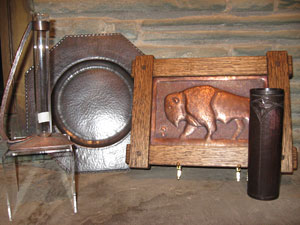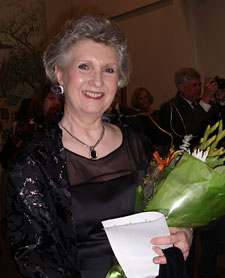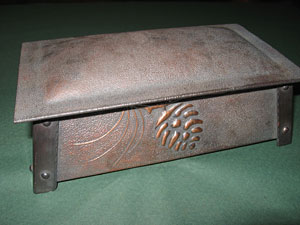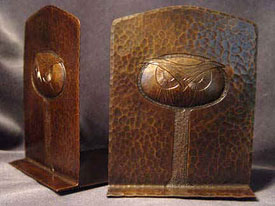Continuing the Copper Legacy of Roycroft
 Roycroft Copper (from left) vase, charger, buffalo, and vase by Roycroft Renaissance Master Artisans David Tundo, Robert Trout, Frank Glapa, and Ron Van Ostrand.
Roycroft Copper (from left) vase, charger, buffalo, and vase by Roycroft Renaissance Master Artisans David Tundo, Robert Trout, Frank Glapa, and Ron Van Ostrand.Photograph courtesy of Roycroft Campus Corporation
In the late 19th century, a reformist community of craft workers, artists, coppersmiths, and bookbinders known as Roycrofters helped shape the the Arts and Crafts movement in the United States. Today, that legacy lives on at the Roycroft Campus, located in East Aurora, NY, a historic site where visitors can learn about the Roycroft philosophy, take classes, and visit the original structures of the community, including the Inn, the Chapel, the Print Shop, the Furniture Shop, and a working Copper Shop.
The Roycroft movement began with Elbert Hubbard, a charismatic American writer, publisher and philosopher born in 1856, whose first successful business venture was as a salesman with Larkin soap company.
During a journey to Europe, he developed a fascination with the Arts and Crafts Movement occurring there, especially the guilds, which were the center of craftsmanship and philosophy. When he returned to the United States, he purchased a huge property in East Aurora, New York, and established a community which he called Roycroft.
Hubbard bought a printing press and created a bindery building where he published his two magazines, The Philistine and The Fra. He also put out mass quantities of his pamphlet, "Message to Garcia," which promoted hard work and self-reliance. Books were crafted on handmade butcher paper. Furniture and leather shops, a Power House and Chapel were also erected on the Campus. However, the heavy influence of Mission-style, hammered copper goods cannot be ignored as it became the basis for beautiful handmade pieces. Soon, artisans from all over came to learn the craft, then make and sell things.
The Blacksmith Shop, started around 1902 on a dirt floor, provided metalwork to the buildings being constructed and hardware for the businesses created. According to Roycroft metal collector, David Kornacki, in an interview with Collectors' Weekly, in 2008, "The first piece produced was a letter opener and pen tray from 1906. Early vases were hammered out over anvils or stakes. Later, after Hubbard and his second wife, Alice, died at sea, a lathe machine spun the smooth copper to form the vases. Still, 1920-1926 was the 'heyday' of the Roycroft Copper Shop. They made large quantities and full lines of everything including vases, bowls, candlesticks, cigar boxes and ash trays."
 Christine Peters, Executive Director at Roycroft Campus Corp. for the Power House dedication in January 2012.
Christine Peters, Executive Director at Roycroft Campus Corp. for the Power House dedication in January 2012. Photograph courtesy of Roycroft Campus Corporation
Circa 1910, concrete blocks had been added to house the growing Art Copper Department, which replaced wrought iron items. It is believed to have been crafted on-site by Roycrofters. The original plaster finish is still evident. A wooden floor contained work benches and a concrete floor supported the heavy equipment.
A Finishing Room was completed with 8" x 16" blocks, the same dimensions used in modern times, and housed stone faced walls. Here, finished copper pieces were washed and plated or patinized. In 2006, the roof of the Finishing Room was totally replaced while workshop projects continued as usual at the restored Campus.
From the end of the 19th through the first few decades of the 20th century, business in the Copper Shop was thriving as Roycrofters produced a variety of hand-hammered copper vases, lamps, candleholders, humidors and bowls. Extremely skilled masters created copper bookends, desk calendars, hammered and riveted inkwells or hammered and punched serving trays.
Leon Varley, who worked at the Roycroft Copper Shop from 1913-1921, fondly recalled his experience there during a 1978 interview when he was age 88. "After five years, I achieved master craftsman status, only three out of 35 at the time. Everyone had his own job to perform. Mine was making oval service trays. Up until the time I left there, I made every oval tray that
ever went out of the shop."
Hubbard's son, Bert, took over the campus operations after his father's death but sold off the buildings in 1938 to individual owners. Working under reduced capacity following the stock-market crash, World War II and change in people's tastes, bankruptcy was eventually declared in 1987.
 Copper box by Roycroft Renaissance Master Artisan Frank Glappa
Copper box by Roycroft Renaissance Master Artisan Frank GlappaPhotograph courtesy of Roycroft Campus Corporation
Various business leaders formed a group that took a vote in 2004 to restore the community. Christine Peters, the Executive Director, says, "It was named Roycroft Campus Corporation to better reflect the organization's mission to promote the ideals, traditions, architectural and business skills of Hubbard through acquisition of the buildings and grounds. The group was instrumental in bringing back the Roycroft Inn which reopened in 1995." The center of the community, the Inn offers breakfast, lunch, dinner and brunch, accommodations including a variety of suites and many special events like the Jazz Festival.
Today, the Campus contains the most complete complex of buildings remaining in the United States, with rare handcrafted details throughout, including an impressive hammered-copper fireplace hood, one of the largest pieces made at the Roycroft, located in the Copper Shop.
In 1986, the Campus was designated a National Historic Landmark district (NHL) and today contains fourteen of the original structures. After the Roycroft Campus Corporation took over, buildings including the Chapel with its beautiful Tiffany windows, the Print Shop, the Furniture Shop and the Copper Shop were refurbished. The original massive oak Print Shop door was restored with Hubbard's motto, "Blessed Is That Man Who Has Found His Work."
Master artisans like Frank Glappa display their even accuracy of hammer work on the Campus. "I created the copper repousse sign for the Copper Shop, which hangs from the tree outside," he says. "It began as a flat sheet of copper until hammered on both the front and back forcing the letters and Roycroft mark into raised relief form." He also produced the copper sign on the mailbox beside the front door.
Glappa holds weekend workshops teaching repousse techniques and metalsmithing that includes hammering, metal stamping, simple chasing, annealing, copper patination (Aurora Brown), wax or lacquer finishes, work holding and limited soldering operations in the remodeled Power House. Projects include letter openers and napkin holders.
 Owl Bookends by Roycroft Renaissance Master Artisan Ron Van Ostrand
Owl Bookends by Roycroft Renaissance Master Artisan Ron Van OstrandPhotograph courtesy of Roycroft Campus Corporation
On August 25 and 26, a tool-making class will instruct on how to create chasing and repousse tools, plus tool tempering. Time is usually sufficient to make three pieces.
"We are extremely busy right now, especially with the Summer Youth Camp," says Executive Director, Christine Peters. "Classes are held until school starts again for children of all ages in a variety of media. They do sketching, bookbinding, hand carved wood blocks, kaleidoscopes, creative writing, fiber arts/mosaics and sight reading of music. Students are currently learning hand-illumination and recently the 12- to 15-year-olds created bowls out of sheet metal copper, working with their hands in the tradition of Hubbard under the instruction of accomplished artisans."
Walking tours guided by trained, well-informed docents take place through the end of October and they can answer questions about the history of the Campus and grounds. The Elbert Hubbert Roycroft Museum, located a block away, provides extensive information on the man who started it all with his "can-do" optimism. Customized tours for ten or more can be provided into and around the restored buildings. School trips and youth organizations are welcome so that students can learn about arts, literature, business and U.S. history at the turn of the 19th and beginning of the 20th centuries. The idea of creating hands-on is consistent with Hubbard's philosophy, still resonant today as young people work with craftsmen to learn metalwork basics.
"Many of our special interactive events are extremely popular. The annual Summer Crafts Festival that concluded in June draws artisans from everywhere and offers detailed demonstrations where people can be taught skills like metalworking, bookbinding, jewelry making, printing and painting. We hold the weekend metalworking classes throughout the year. In the future, we are hoping to expand this into a week-long program with the addition of more instructors and to increase our hands-on, multi-educational programs and events in our unique architectural setting."
Resources:
Also in this Issue:
- Continuing the Copper Legacy of Roycroft
- Bringing New Life to Early Culinary Copper
- The Lure of Curiously Historic Coins Minted from Copper
- Copperton Lane: Specializing in Antique to Mid-Century Copper Items
- Princeton University of Art Unveils Monumental Bronze Sculptures by Ai Weiwei
